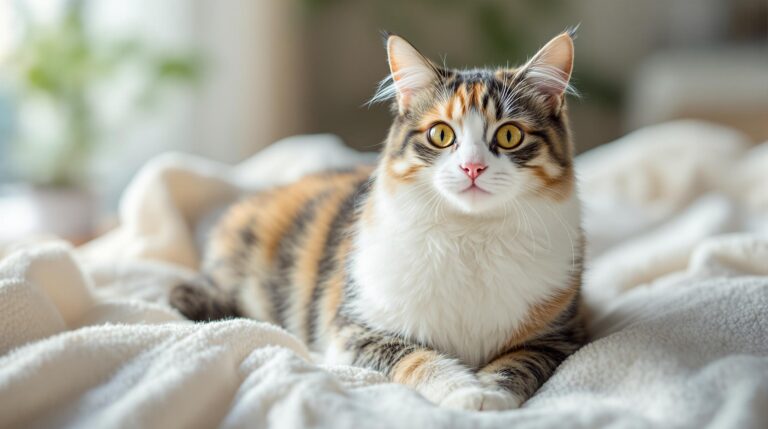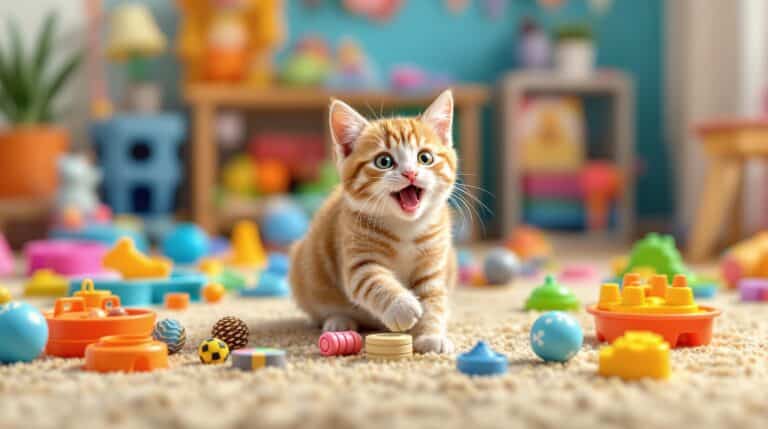Understanding your cat’s respiratory rate can help you identify potential issues early and ensure your feline friend stays healthy. At Cat Karma Creations, we understand the importance of your pet’s well-being, and we want to guide you through the normal respiratory rate for cats, common respiratory problems, and how to measure and interpret your cat’s breathing rate. By the end, you’ll be better equipped to recognize signs of respiratory distress and know when to seek veterinary care.
Normal Cat Respiratory Rate
What is a Normal Respiratory Rate for Cats?
The normal respiratory rate for cats is typically between 20 to 30 breaths per minute. However, this can vary based on several factors, including age, activity level, and overall health. Kittens and younger cats may have slightly higher rates, while older cats might have a lower respiratory rate. It’s essential to understand what is normal for your cat to recognize when something is wrong. If you have any concerns, don’t hesitate to contact us at (800) 343-1604 or visit our contact form.
Factors Affecting Respiratory Rate
Several factors can influence a cat’s respiratory rate. These include:
- Age: Kittens and younger cats often have a higher respiratory rate due to their higher metabolism and activity levels.
- Activity level: A cat that has been exercising or playing will have a higher respiratory rate compared to a resting cat.
- Environmental temperature: Cats in warmer environments may breathe faster to cool down.
- Stress or anxiety: Stress can cause a cat to breathe more rapidly.
- Health conditions: Various health issues, such as respiratory infections or heart problems, can affect a cat’s breathing rate.
Understanding these factors can help you interpret your cat’s respiratory rate more accurately and identify when there might be a problem.
How to Measure Your Cat’s Respiratory Rate
Measuring your cat’s respiratory rate is a simple process that can be done at home. Here’s a step-by-step guide:
- Choose a quiet, calm environment where your cat is relaxed and not stressed.
- Observe your cat’s chest movements. You can count the number of breaths by watching the rise and fall of the chest or placing your hand near the cat’s nose to feel the breaths.
- Count the number of breaths your cat takes in 15 seconds and multiply that number by 4 to get the respiratory rate per minute.
- Repeat the measurement a few times to ensure accuracy.
- Record the results and compare them to the normal range of 20 to 30 breaths per minute.
Regularly monitoring your cat’s respiratory rate can help you detect any changes early and take appropriate action if needed. For more tips on cat care, visit our All Jewelry page for some stylish and unique cat-themed gifts.
Common Cat Respiratory Problems
Cat Asthma
Cat asthma is a common respiratory condition that affects many cats. It is characterized by inflammation of the airways, which can lead to symptoms such as wheezing, coughing, and labored breathing. The exact cause of cat asthma is often unknown, but it can be triggered by allergens, stress, and environmental irritants.
Treatment for cat asthma typically involves the use of bronchodilators and corticosteroids to reduce inflammation and open the airways. In severe cases, oxygen therapy may be necessary. Managing the condition also involves avoiding known triggers, reducing stress, and maintaining regular veterinary check-ups. The prognosis for cats with asthma is generally good with proper management, although it is a chronic condition that requires ongoing care.
Upper Respiratory Infections (URIs)
Upper respiratory infections (URIs) are another common respiratory problem in cats. These infections can be caused by viruses, bacteria, or fungi and typically present with symptoms such as sneezing, runny nose, fever, and coughing. URIs are highly contagious and can spread easily among cats, especially in multi-cat households or shelters.
Treatment for URIs often includes antibiotics, antivirals, and supportive care to manage symptoms and prevent complications. Preventive measures include vaccinations, good hygiene, and avoiding exposure to sick cats. Early treatment is crucial for a good prognosis, and most cats recover well with appropriate care.
Pneumonia
Pneumonia is a serious respiratory infection that affects the lungs and can be caused by bacteria or viruses. Symptoms of pneumonia in cats include fever, rapid breathing, lethargy, and coughing. This condition can be life-threatening if left untreated and requires prompt veterinary attention.
Treatment for pneumonia typically involves antibiotics, oxygen therapy, and supportive care. Preventive measures are similar to those for URIs, including vaccinations, good hygiene, and avoiding exposure to sick cats. Early detection and treatment are essential for a good prognosis, although the condition can be severe if not addressed promptly.
Cat Breathing Difficulties
Cats can experience a range of breathing difficulties, including labored breathing, wheezing, and coughing. These symptoms can be caused by various factors, such as respiratory infections, asthma, heart problems, or other underlying health conditions. It’s important to recognize the signs of breathing difficulties and seek veterinary care if you notice any changes in your cat’s breathing pattern.
Some common signs of breathing difficulties in cats include:
- Labored breathing or difficulty breathing (dyspnea)
- Rapid breathing (tachypnea)
- Wheezing or whistling sounds when breathing
- Coughing or gagging
- Open-mouth breathing or panting
- Abdominal effort when breathing
If you observe any of these symptoms, it’s crucial to contact your veterinarian for a thorough examination and appropriate treatment. For more information, visit our Cat Themed Jewelry page.
Signs of Respiratory Distress in Cats
Rapid Breathing
Rapid breathing, also known as tachypnea, is a common sign of respiratory distress in cats. It can be caused by various factors, including stress, overheating, pain, anxiety, or underlying health issues such as respiratory infections or heart problems. If you notice your cat breathing faster than the normal rate of 20 to 30 breaths per minute, it’s important to monitor the situation and consult a veterinarian if the rapid breathing persists or is accompanied by other symptoms.
Labored Breathing
Labored breathing, or dyspnea, is another serious sign of respiratory distress in cats. It is characterized by difficulty breathing, with the cat making visible efforts to breathe, such as using the abdominal muscles or breathing with an open mouth. Labored breathing can be caused by conditions such as asthma, pneumonia, heart failure, or blockages in the airways. If you notice your cat struggling to breathe, it’s essential to seek immediate veterinary care to identify and treat the underlying cause.
Wheezing and Coughing
Wheezing and coughing are common symptoms of respiratory issues in cats. Wheezing is a whistling sound that occurs when air passes through narrowed or obstructed airways, often associated with conditions like asthma or bronchitis. Coughing can be a sign of various respiratory problems, including infections, allergies, or heart issues. If your cat is wheezing or coughing, it’s important to consult a veterinarian to determine the cause and appropriate treatment.
Panting and Open-Mouth Breathing
Panting and open-mouth breathing are not typical behaviors for cats and can be signs of respiratory distress. Panting can be a response to stress, overheating, or underlying health issues such as pain or respiratory infections. Open-mouth breathing is a more serious sign and can indicate severe respiratory distress, often seen in conditions like asthma or heart failure. If your cat is panting or breathing with an open mouth, it’s crucial to seek veterinary care immediately to address the underlying cause and provide relief.
Managing and Preventing Respiratory Issues
Veterinary Care and Treatment
Regular veterinary check-ups are essential for monitoring your cat’s respiratory health and catching any issues early. If your cat is showing signs of respiratory distress or other respiratory problems, it’s important to consult a veterinarian for a thorough examination and appropriate treatment. Your vet can diagnose the underlying cause and recommend the best course of action, which may include medications, lifestyle changes, or other interventions.
Home Care and Monitoring
In addition to veterinary care, home care and monitoring play a crucial role in managing and preventing respiratory issues in cats. Here are some tips for home care:
- Regularly check your cat’s respiratory rate and watch for any changes or signs of distress.
- Keep your cat’s environment clean and free from irritants, such as smoke, dust, and strong odors.
- Provide a comfortable, quiet space for your cat to rest and recover.
- Monitor your cat’s activity level and behavior for any signs of discomfort or illness.
- Follow your veterinarian’s recommendations for medications and treatments.
By staying vigilant and proactive, you can help your cat maintain good respiratory health and catch any issues early. For more tips and support, follow us on Facebook and Instagram.
Environmental Factors and Allergens
Environmental factors can significantly impact your cat’s respiratory health. Common allergens and irritants include:
- Air pollutants and smog
- Cigarette smoke
- Dust and mold
- Strong odors and fragrances
- Pollen and other allergens
To create a cat-friendly environment that supports respiratory wellness, consider the following:
- Use air purifiers to reduce air pollution and allergens in your home.
- Avoid smoking or using strong fragrances around your cat.
- Regularly clean and vacuum your home to reduce dust and mold.
- Keep windows closed during high-pollen seasons.
- Use hypoallergenic bedding and litter.
By minimizing exposure to these irritants, you can help reduce the risk of respiratory issues in your cat.
Diet and Nutrition for Respiratory Health
A balanced and nutritious diet can play a significant role in supporting your cat’s respiratory health. Foods rich in antioxidants, vitamins, and minerals can help reduce inflammation and support the immune system. Consider the following dietary tips:
- Choose high-quality, grain-free cat foods that are rich in omega-3 fatty acids.
- Incorporate foods with anti-inflammatory properties, such as fish oil and turmeric.
- Ensure your cat has access to fresh, clean water to stay hydrated.
- Avoid feeding your cat foods that can trigger allergies or inflammation, such as dairy and certain grains.
- Consult your veterinarian for recommendations on specific dietary needs for your cat’s respiratory health.
By providing a healthy diet, you can support your cat’s overall respiratory function and reduce the risk of respiratory issues.
Comparison of Common Cat Respiratory Conditions
| Feature | Cat Asthma | Upper Respiratory Infections (URIs) | Pneumonia |
|---|---|---|---|
| Symptoms | Wheezing, coughing, labored breathing | Sneezing, runny nose, fever, coughing | Fever, rapid breathing, lethargy, coughing |
| Causes | Allergies, stress, environmental irritants | Viruses, bacteria, fungi | Bacterial or viral infection |
| Treatment | Bronchodilators, corticosteroids, oxygen therapy | Antibiotics, antivirals, supportive care | Antibiotics, oxygen therapy, supportive care |
| Prevention | Avoid allergens, reduce stress, regular vet check-ups | Vaccinations, good hygiene, avoid exposure to sick cats | Vaccinations, good hygiene, avoid exposure to sick cats |
| Prognosis | Good with management, chronic condition | Good with early treatment, can be recurrent | Good with early treatment, can be severe if untreated |
Understanding the differences between these conditions can help you recognize the signs and seek appropriate treatment for your cat.
Popular Quote
“A cat improves the garden wall in sunshine and the hearth in rain.” — William Butler Yeats
This quote beautifully captures the comforting presence of cats in our lives, whether they are basking in the sun or keeping us company on rainy days.
Statistical Fact
According to the American Veterinary Medical Association (AVMA), approximately 30% of cats will experience some form of respiratory issue during their lifetime. This statistic underscores the importance of regular veterinary check-ups and proactive care to ensure your cat’s respiratory health.
Source: American Veterinary Medical Association
Three Tips for Maintaining Your Cat’s Respiratory Health
- Regular Check-Ups: Schedule regular veterinary check-ups to monitor your cat’s respiratory health and catch any issues early.
- Healthy Environment: Create a clean and allergen-free environment by using air purifiers, avoiding strong fragrances, and keeping your home well-ventilated.
- Proper Diet: Feed your cat a balanced and nutritious diet rich in antioxidants and omega-3 fatty acids to support their immune system and respiratory health.
Popular Questions
What are the signs of respiratory distress in cats?
The signs of respiratory distress in cats include rapid breathing, labored breathing, wheezing, coughing, open-mouth breathing, and abdominal effort when breathing. If you notice any of these symptoms, it’s important to seek veterinary care immediately.
How can I prevent respiratory issues in my cat?
To prevent respiratory issues in your cat, ensure regular veterinary check-ups, maintain a clean and allergen-free environment, and provide a balanced and nutritious diet. Avoid exposure to irritants like cigarette smoke and strong odors, and keep your cat’s living space well-ventilated.
What should I do if my cat is wheezing?
If your cat is wheezing, it’s important to consult a veterinarian to determine the cause and appropriate treatment. Wheezing can be a sign of respiratory issues such as asthma or bronchitis, and early intervention can help manage the condition effectively.
Can stress cause respiratory problems in cats?
Yes, stress can cause respiratory problems in cats. Stress can lead to rapid breathing, wheezing, and other signs of respiratory distress. Reducing stress through a calm environment, regular playtime, and a consistent routine can help prevent these issues.
Final Thoughts About Cat’s Respiratory Rate
Understanding your cat’s respiratory rate is a vital part of maintaining their overall health. By recognizing the signs of respiratory distress and knowing when to seek veterinary care, you can ensure your feline friend stays happy and healthy. Regular monitoring and preventive measures can help you catch issues early, leading to better outcomes. If you have any concerns about your cat’s breathing, don’t hesitate to contact your veterinarian for a thorough check-up. For unique and stylish cat-themed gifts, visit our Nature Inspired collection.
At Cat Karma Creations, we are dedicated to supporting cat owners in every aspect of their pet’s well-being. If you have any questions or need further assistance, feel free to reach out to us at (800) 343-1604 or through our contact form. Together, we can ensure your cat lives a long, healthy, and happy life.
















